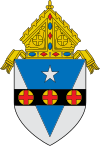
The Papal Basilica of Saint Peter in the Vatican, or simply Saint Peter's Basilica, is a church in the Italian Renaissance style located in Vatican City, an independent microstate enclaved within the city of Rome, Italy. It was initially planned in the 15th century by Pope Nicholas V and then Pope Julius II to replace the aging Old St. Peter's Basilica, which was built in the fourth century by Roman emperor Constantine the Great. Construction of the present basilica began on 18 April 1506 and was completed on 18 November 1626.

Cathedrals, collegiate churches, and monastic churches like those of abbeys and priories, often have certain complex structural forms that are found less often in parish churches. They also tend to display a higher level of contemporary architectural style and the work of accomplished craftsmen, and occupy a status both ecclesiastical and social that an ordinary parish church rarely has. Such churches are generally among the finest buildings locally and a source of regional pride. Many are among the world's most renowned works of architecture. These include St Peter's Basilica, Notre-Dame de Paris, Cologne Cathedral, Salisbury Cathedral, Antwerp Cathedral, Prague Cathedral, Lincoln Cathedral, the Basilica of Saint-Denis, Santa Maria Maggiore, the Basilica of San Vitale, St Mark's Basilica, Westminster Abbey, Saint Basil's Cathedral, Antoni Gaudí's incomplete Sagrada Família and the ancient cathedral of Hagia Sophia in Istanbul, now a mosque.
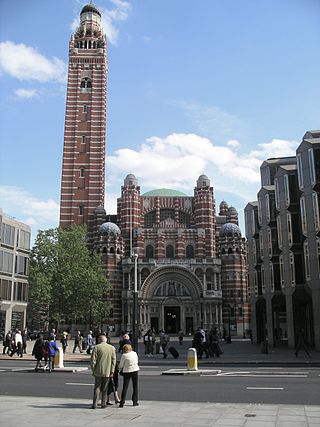
Westminster Cathedral is the mother church of the Catholic Church in England and Wales. It is the largest Catholic church in the UK and the seat of the Archbishop of Westminster.

The Cathedral Basilica of Saint Louis, also known as the Saint Louis Cathedral, is a Catholic cathedral in the Central West End neighborhood of St. Louis, Missouri. Completed in 1914, it is the mother church of the Archdiocese of St. Louis and the seat of Archbishop Mitchell T. Rozanski. The cathedral is named for Saint Louis and was designated a basilica by Pope John Paul II in 1997.

The Basilica of the National Shrine of the Immaculate Conception is a large minor Catholic basilica and national shrine in the United States in Washington, D.C., located at 400 Michigan Avenue Northeast, adjacent to Catholic University.
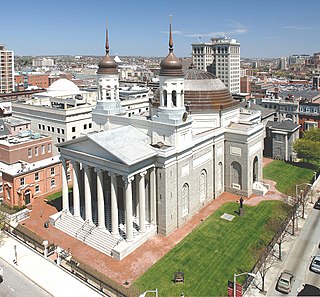
The Basilica of the National Shrine of the Assumption of the Blessed Virgin Mary, also called the Baltimore Basilica, is a Catholic cathedral in Baltimore, Maryland. It was the first Catholic cathedral built in the United States after the nation's founding, and was among the first major religious buildings constructed therein after the adoption of the U.S. Constitution.

Dennis Joseph Dougherty was an American prelate of the Catholic Church. He served as Archbishop of Philadelphia from 1918 until his death in 1951, and was made a cardinal in 1921. He was Philadelphia's longest-serving archbishop and its first cardinal.
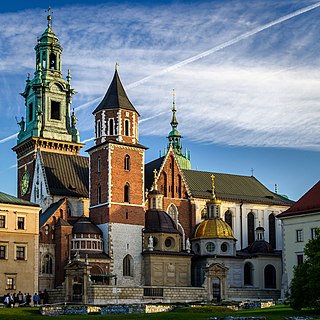
The Wawel Cathedral, formally titled the Archcathedral Basilica of Saint Stanislaus and Saint Wenceslaus, is a Catholic cathedral situated on Wawel Hill in Kraków, Poland. Nearly 1000 years old, it is part of the Wawel Castle Complex and is a national sanctuary which served as the coronation site of Polish monarchs.

St. Michael's Cathedral Basilica is the cathedral church of the Roman Catholic Archdiocese of Toronto, Canada, and one of the oldest churches in Toronto. It is located at 65 Bond Street in Toronto's Garden District. St. Michael's was designed by William Thomas, designer of eight other churches in the city, and was primarily financed by Irish immigrants who resided in the area. The cathedral has a capacity of 1600. John Cochrane and Brothers undertook the work on the stone and stucco ornamentation of the interior.
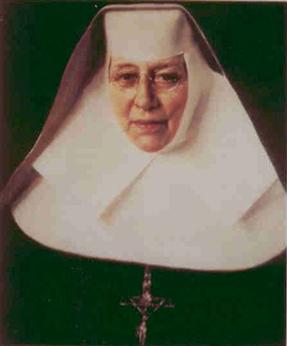
Katharine Drexel, SBS was an American Catholic heiress, philanthropist, religious sister, and educator. In 1891, she founded the Sisters of the Blessed Sacrament, a religious order serving Black and Indigenous Americans.

The Basilica-Cathedral of St. John the Baptist in St. John's, Newfoundland and Labrador is the metropolitan cathedral of the Roman Catholic Archdiocese of St. John's, Newfoundland and the mother church and symbol of Roman Catholicism in Newfoundland. The building sits within the St. John's Ecclesiastical District, a National Historic District of Canada.

The Archdiocese of Indianapolis is a Latin Church diocese of the Catholic Church in Indiana in the United States.
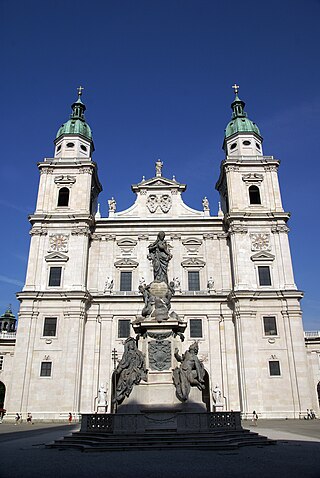
Salzburg Cathedral is the seventeenth-century Baroque cathedral of the Roman Catholic Archdiocese of Salzburg in the city of Salzburg, Austria, dedicated to Saint Rupert and Saint Vergilius. Saint Rupert founded the church in 774 on the remnants of a Roman town, and the cathedral was rebuilt in 1181 after a fire. In the seventeenth century, the cathedral was completely rebuilt in the Baroque style under Prince-Bishop Wolf Dietrich von Raitenau to its present appearance. Salzburg Cathedral still contains the baptismal font in which composer Wolfgang Amadeus Mozart was baptized.

John Notman was a Scottish-born American architect and landscape architect based in Philadelphia. He designed buildings, cemeteries, churches and country estates in the Mid-Atlantic region of the United States and helped popularize Italianate architecture in the United States.

The Cathedral of the Blessed Sacrament is a Roman Catholic cathedral located at One Cathedral Square in Altoona, Pennsylvania. It is within the boundaries of the Downtown Altoona Historic District, and was added to the National Register of Historic Places in 1992. It is the mother church of the Diocese of Altoona-Johnstown and is the seat of its bishop, the Most Reverend Mark Leonard Bartchak. The Cathedral of the Blessed Sacrament Pastor is Rev. Monsignor Stanley B. Carson, Administrator.

Padua Cathedral, or Basilica Cathedral of Saint Mary of the Assumption, is a Catholic church and minor basilica located on the east end of Piazza Duomo, adjacent to the bishop's palace in Padua, Veneto, Italy.

Joseph Anthony Pepe is an American prelate of the Roman Catholic Church. He served as the second bishop of the Diocese of Las Vegas in Nevada from 2001 to 2018.
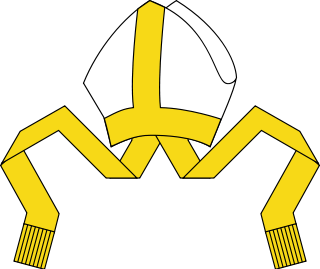
Robert Patrick Maginnis was an American prelate of the Roman Catholic Church. He served as an auxiliary bishop of the Archdiocese of Philadelphia from 1996 to 2010.
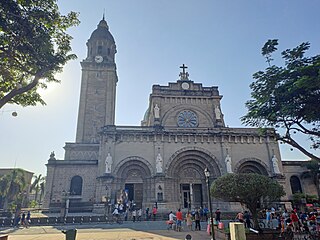
The Minor Basilica and Metropolitan Cathedral of the Immaculate Conception, commonly and popularly known as the Manila Cathedral, is a Roman Catholic minor basilica and the cathedral church of the Archdiocese of Manila located in Intramuros, the historic walled city within today's modern city of Manila, Philippines. It is dedicated to the Immaculate Conception of the Blessed Virgin Mary as the patroness of the country.

Saints Peter and Paul Cathedral is a Roman Catholic cathedral located at Fourteenth and Meridian Streets in Indianapolis, Indiana, United States. It is the seat of the Archdiocese of Indianapolis, and of the Archbishop of Indianapolis, most recently Archbishop Charles C. Thompson. Silas Chatard, the first Bishop of Indianapolis, established the cathedral parish in 1892, and named it after Saint Peter and Saint Paul, two apostles of Christ. The cathedral parish became known for its liturgical celebrations and sacred music performances.





























